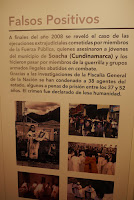 |
| Inside Bogotá's newest museum - the Fiscalia's. |
 |
| Carlos Lehder. |
Yep, seriously. The Fiscalia, or Attorney General, the agency charged with accusing and prosecuting criminals, has played a key role in the biggest dramas in Colombia's recent decades, many of which are on display in the new museum. Most impressively, the museum also includes the government's own sins.
The museum is also unintentionally a testament to the violence, corruption and general mayhem which drug prohibitionism has inflicted on Colombia. Not surprisingly, one subject the museum does not touch is decriminalization - despite its demonstrated success - because it would take away the Fiscalia's business.
Everybody's heard of Pablo Escobar, but many fewer know the name Carlos Lehder - even tho he was crazier and perhaps even richer than Escobar. Lehder admired both John Lennon and Adolf Hitler. He tried starting his own populist political party. And he even bought a Caribbean island, kicked off the inhabitants and used it to party and stockpile cocaine. But he was so unstable that Escobar supposedly betrayed him to the DEA. Lehder is still rotting away in a U.S. federal prison.
 |
| Model of an early drug-smuggling sub. |
 |
| Martyred Justice Minister Rodrigo Lara Bonillo. |
Another less-remembered character of the era was the crusading Minister of Justice Rodrigo Lara Bonillo, who prosecuted members of the Medellin cartel and was gunned down for it in Bogotá in 1984. His killing triggered the war between the government and Esocbar.
In the end, the leaders of the less-famous Cali cartel were captured and extradited to U.S. prisons, where some still remain. In contrast, many Medellin cartel leaders gave themselves up and received short sentences in Colombia - despite being much more murderous.
 |
| A jet ski which supposedly belonged to Pablo Escobar. |
 |
| Bloque de Busqueda members looking at Esocbar's corpse on a Medellin rooftop in 1993. |

In the Proceso 8000, Liberal Party Pres. Ernesto Samper's (1994-98) presidential campaign was discovered to have received money from the Cali cocaine cartel.
The investigation brought the conviction of other government officials, but Samper himself was found 'neither guilty nor innocent' by a Congress - altho today few doubt he knew about the dirty money. It led to Washington canceling Samper's U.S. Visa - a huge embarrasment for a close ally - and the U.S. The episode was named after a folder containing key documents - altho I did not see that folder in the museum.
 |
| Cali cartel leaders on their way to prison in the U.S. |
 |
| Display about the FARC guerrillas. |
 |
| A captured FARC document listing weapons, including gun cartridges and explosives. |
 |
| FARC propaganda. |
 |
| A laptop belonging to FARC leader 'Mono Jojoy' recovered after he was killed in a government bombardment in 2010. |
Probably the darkest chapter in recent Colombia history was paramilitarism - the right-wing death squads organized by landowners with government and military collaboration, which carried out many massacres, often of campesinos, including women and children, based only on suspicion of sympathy for the guerrillas.
 |
| The jeep driven by police investigating crimes in 1989 in Santander Department. |
One of the more notorious of the massacres carried out by paramilitaries with collaboration from the regular military was that of La Riochela, in 1989 in Santander Department. Fifteen judicial investigators had traveled to a remote area to investigate killings. Paramilitary fighters stopped them and cold bloodedly murdered twelve of them under orders from a Medellin cartel leader and with support from the regular military. After the killings, the 'paras' hid their weapons in a military base.
 |
| Victims of the La Rochela massacre. |
Yet another dark chapter involving the regular military were the 'false positives' killings during the
Uribe government. At that time, the military gave military units rewards of bonuses and time off for killing guerrillas. Some units responded by kidnapping poor young men, killing them and disguising them as guerrillas in order to collect the rewards. The killings received national attention when a group of young men were kidnapped from Soacha, in south Bogotá, and later found dead near the Venezuelan border, labeled as guerrillas.
 |
| An exhumation kit for buried corpses. |
Running thru the museum's displays, of course, is the subject of drug trafficking, which has helped finance nearly all of Colombia's violent groups (and some non-violent ones).
 |
| A cocaine.making lab. Lots of chemicals involved. Cocaine is niether green nor organic. |
 |
| Coffee beans with cocaine inside. |
 |
| 'Candies' used for smuggling cocaine. |
 |
| Colombian clock used for smuggling cocaine. |
 |
| Pool balls, used for smuggling cocaine. |
 |
| A car tire used for smuggling cocaine. |
 |
| The Museo de la Fiscalia is located in this building on Carrera 13 just south of Calle 19, in central Bogotá. |
You can leave your bike in the parking lot across the street. Admission is free.
By Mike Ceaser, of Bogotá Bike Tours






No comments:
Post a Comment